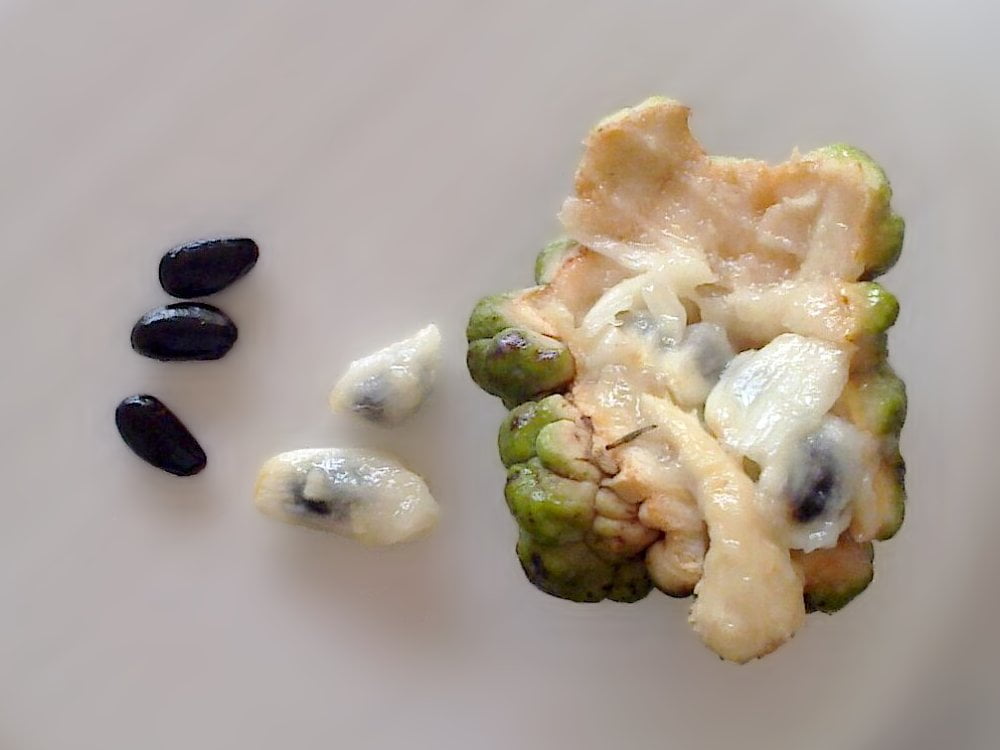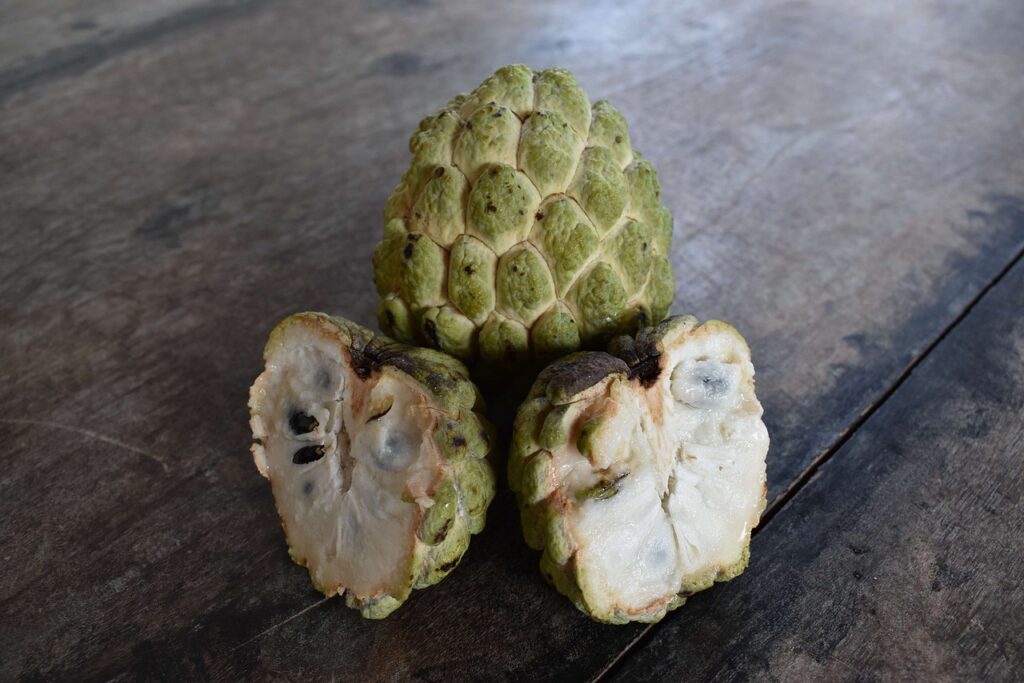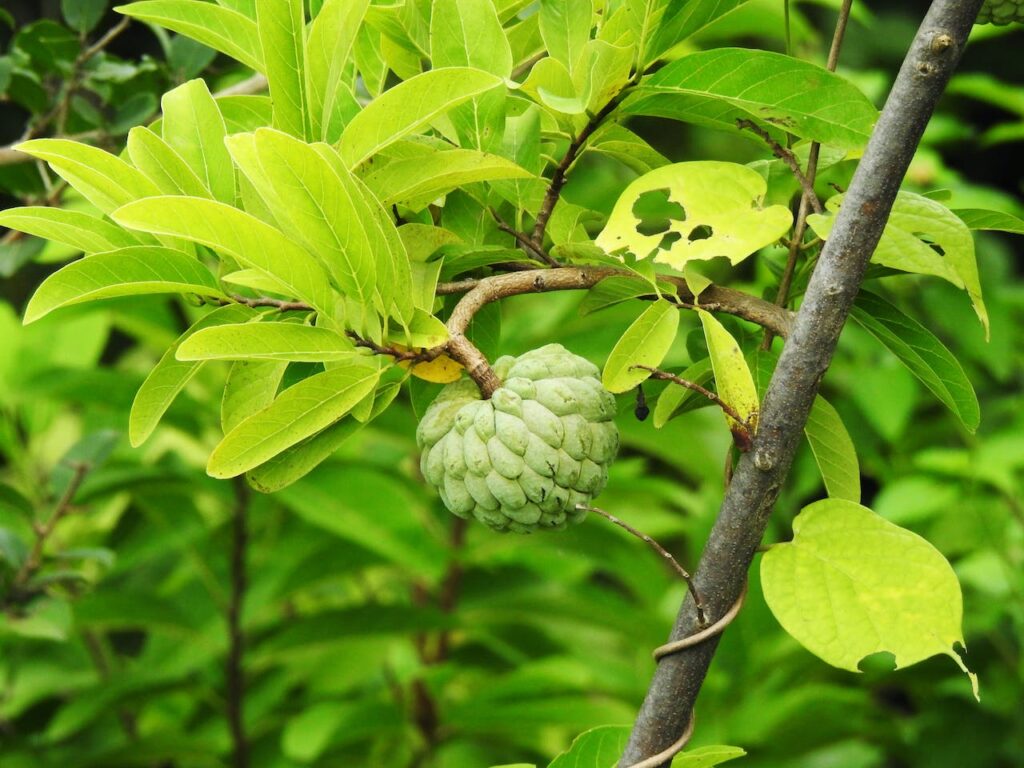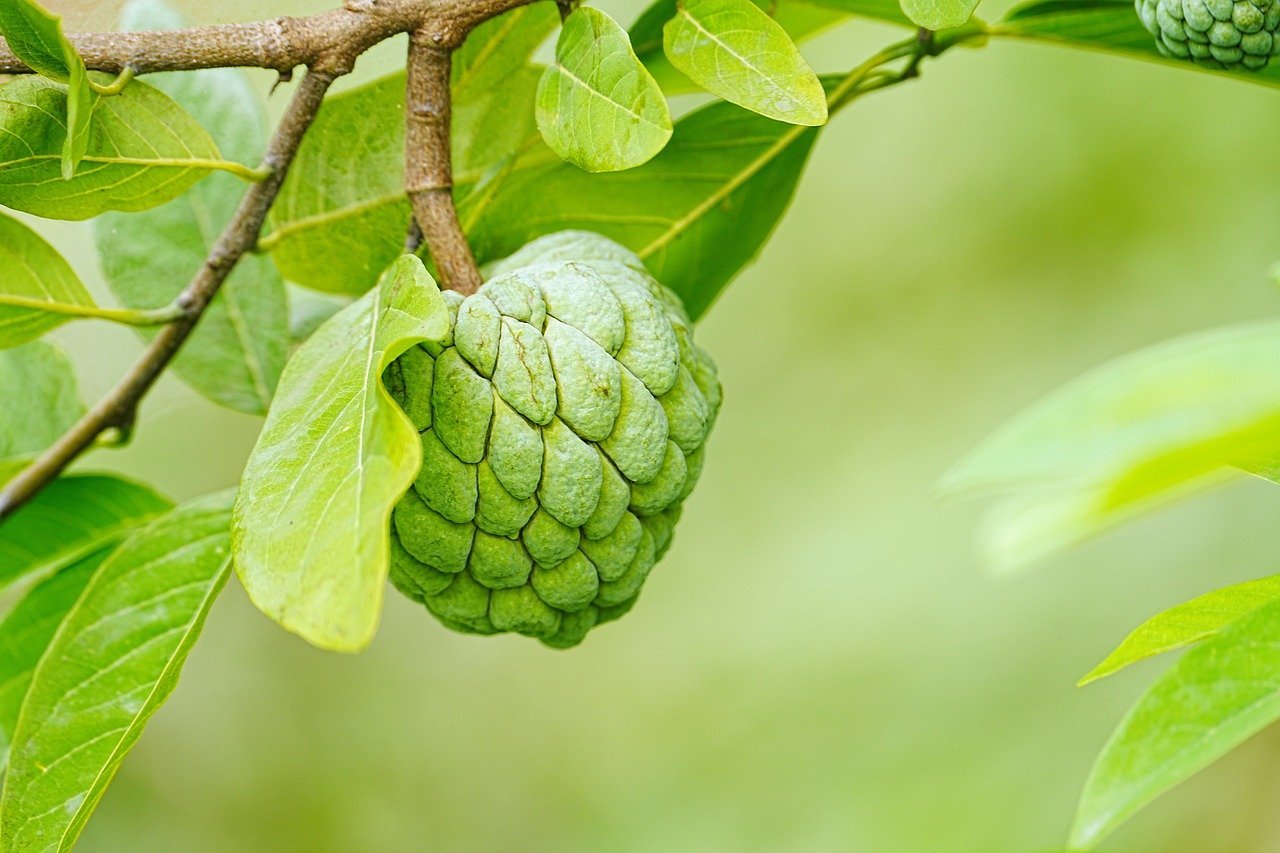Atis Fruit (Or Sugar Apples in English) are tropical fruits that captivate both the eye and the palate. With a sweet taste reminiscent of a blend of pineapple, banana, and pear, these fruits have earned a special place in the hearts of fruit enthusiasts around the world.
In this article, we will delve into the origin, characteristics, nutritional benefits, and cultivation practices of Atis.
Origin of Atis (Sugar Apples)
Atis (Sugar Apples), scientifically classified as Annona squamosa, trace their roots to the tropical Americas, specifically the West Indies and parts of Central and South America.
Over time, these captivating fruits have embarked on a journey across the globe, finding cultivation in various tropical and subtropical regions.
Their popularity has soared in countries with warm climates, including India, the Philippines, Australia, and pockets of Africa.
The global dissemination of Atis speaks to their adaptability and the universal appeal of their sweet and unique flavor profile.
Physical Characteristics
Shape and Size
The distinctive appearance of Atis is characterized by a conical or heart-shaped contour, boasting a modest diameter ranging from 5 to 10 centimeters.
Cloaked in knobby, greenish-brown skin, the fruit presents an intriguing exterior that only hints at the deliciousness within.
Flesh
Once opened, the Atis fruit reveals a luscious, white, and creamy flesh that envelopes numerous black seeds.
Often likened to custard, the texture is a delightful blend of smoothness and richness, earning it the moniker “custard apple.”

Aroma
What truly sets Atis fruit apart is their enchanting fragrance—a sweet and enticing aroma that beckons with every bite.
The mere scent of a sugar apple can evoke a sense of tropical paradise.
Ways To Eat Atis Fruit
Atis Fruit, with their delectable combination of flavors and creamy texture, offer a tropical treat that can be enjoyed in various delightful ways. From enjoying them fresh to incorporating them into creative culinary creations, here’s a guide on how to make the most of nature’s sweet gems.
Fresh and Simple
The purest way to relish Atis fruit is to enjoy them fresh. Begin by gently washing the fruit to remove any surface impurities.
Once clean, cut or break the atis open. Carefully separate the flesh from the seeds, and savor the custard-like texture directly.
Allow the natural sweetness to envelop your taste buds, experiencing the unique blend of pineapple, banana, and pear notes.

Smoothies and Juices
For a refreshing and nutritious beverage, incorporate Atis into your favorite smoothie or juice recipes.
Blend sugar apple chunks with other tropical fruits like bananas, mangoes, and a splash of coconut water or your preferred juice.
The result is a delightful concoction that combines the tropical goodness of Atis fruit with other complementary flavors, creating a vibrant and healthful drink.
Dessert
Atis lend themselves beautifully to a variety of desserts:
- Ice Cream Topping: Elevate your ice cream experience by adding slices as a topping. The contrast of the cold, creamy ice cream and the soft, sweet fruit creates a harmonious dessert that’s simple yet indulgent.
- Fruit Salad: Mix sugar apple chunks with other tropical fruits to create a colorful and flavorful fruit salad. Drizzle with honey or lime juice to enhance the natural sweetness, resulting in a refreshing and nutritious dessert.
Baked Goodies
Introduce Atis into your baking adventures:
- Muffins or Bread: Incorporate sugar apple chunks into muffin or bread batter for a delightful twist on classic baked goods. The fruit adds natural sweetness and a creamy texture to your morning or afternoon treats.
- Fruit Tarts: Top your favorite tart or pie with sugar apple slices, creating a visually appealing dessert. The combination of flaky crust and the sweet, creamy fruit makes for a delightful indulgence.
Sauces and Dips
Explore the savory side of Atis:
- Sugar Apple Salsa: Dice Atis and combine them with red onion, cilantro, lime juice, and a hint of chili to create a unique salsa. Pair it with grilled chicken or fish for a delightful and unexpected flavor combination.
- Dip it in Chocolate: For a decadent treat, dip Atis slices in melted chocolate. Allow them to cool and harden, creating a delightful fusion of creamy sweetness and rich chocolate.
Cocktails and Mocktails
Indulge in tropical beverages with a Atis twist:
- Sugar Apple Mojito: Muddle Atis chunks with mint leaves, lime juice, and simple syrup. Mix with your choice of rum or sparkling water for a refreshing mojito that captures the essence of the tropics.
- Virgin Sugar Apple Punch: Combine Atis juice with pineapple juice, ginger ale, and a splash of lime for a non-alcoholic punch. Garnish with fresh mint leaves for a visually appealing and refreshing drink.
Nutritional Benefits Of Atis Fruits
Atis fruits are not only a delight to the taste buds but also pack a nutritional punch. Here are some key health benefits associated with these tropical treats:
Rich in Vitamins
Abundant in vitamin C, Atis contribute to a robust immune system and promote skin health.
The antioxidant properties of vitamin C make Atis a delicious ally in the pursuit of overall well-being.
Dietary Fiber
The high dietary fiber content in Atis fruit facilitates digestion and supports a healthy digestive system.
This fiber-rich fruit can be an excellent addition to a balanced diet, aiding in maintaining digestive regularity.
Mineral Content
Packed with essential minerals like potassium and magnesium, Atis play a role in promoting heart health and facilitating proper muscle function.
These minerals are integral to various physiological processes within the body.
Natural Sugars
While Atis contain natural sugars, their relatively low glycemic index makes them a suitable choice for individuals mindful of their sugar intake.
This characteristic positions Atis fruit as a sweet indulgence without the rapid spikes in blood sugar associated with high-glycemic foods.
Uses Of Atis In Traditional Medicine
Beyond their delectable taste and enchanting aroma, Atis have carved a niche for themselves in traditional medicine across various cultures.
The different parts of the Atis tree, including the fruit, seeds, and leaves, are believed to possess medicinal properties that have been tapped into for centuries.
Skin Soothing Properties
The seeds of the Atis fruit are often used in traditional medicine for their potential skin-soothing properties. Crushed seeds, when applied topically, are believed to aid in the treatment of skin conditions such as eczema and dermatitis.
The natural compounds found in these seeds are thought to have anti-inflammatory and emollient effects, contributing to skin health.
Digestive Aid
In some traditional medicinal practices, Atis fruit are employed to address digestive issues. The fruit’s high dietary fiber content may play a role in promoting a healthy digestive system.
From easing constipation to supporting regular bowel movements, Atis are considered by some to be a natural digestive aid.
Antiparasitic Potential
Certain cultures utilize the leaves of the Atis tree for their potential antiparasitic properties. Infusions or extracts made from the leaves are thought to have properties that could combat certain types of parasites.
This traditional use reflects the rich tapestry of natural remedies woven into cultural practices over generations.
Fever Reduction
In traditional medicine, Atis tree leaves are sometimes employed to help reduce fever.
The leaves are crushed or brewed into a concoction that is believed to have cooling properties, making it a potential remedy for fever in some traditional medicinal practices.
Regulating Blood Sugar
While the fruit itself contains natural sugars, some traditional medicine practitioners believe that Atis may play a role in helping regulate blood sugar levels.
The low glycemic index of Atis, combined with their fiber content, is thought to contribute to a more gradual release of sugars into the bloodstream.
Caution and Consultation
It’s important to note that while Atis have been used in traditional medicine, caution and consultation with healthcare professionals are essential. The efficacy and safety of these traditional remedies can vary, and individual responses may differ.
Integrating Atis into health practices should be done with a thorough understanding of one’s health condition and in consultation with a qualified healthcare provider.
While modern science continues to explore and validate some of these traditional uses, it’s crucial to approach their medicinal potential with respect for cultural traditions and a balanced understanding of contemporary health practices.
Cultivation
Cultivating Atis Tree requires a warm, tropical to subtropical climate. Here are some key points to consider when growing sugar apple trees:

Climate
Thriving in temperatures between 25 to 30 degrees Celsius (77 to 86 degrees Fahrenheit), Atis are sensitive to frost and require protection during colder periods.
This tropical to subtropical climate preference underscores the need for warm conditions for successful cultivation.
Soil
The foundation of successful cultivation lies in well-draining, fertile soil with a slightly acidic to neutral pH.
Ensuring the right soil conditions is paramount for the health and productivity of Atis trees.
Watering
While Atis trees appreciate consistent moisture, they are susceptible to waterlogging, making adequate drainage crucial to prevent root rot.
Balancing hydration is key to their overall well-being.
Sunlight
Flourishing in full sunlight, Atis should be planted in locations with ample sun exposure.
This requirement underscores the importance of choosing the right planting site to optimize growth and fruit development.
Pruning
Regular pruning practices are essential for maintaining the tree’s shape, promoting air circulation, and facilitating the harvesting process.
Pruning also contributes to the overall health and vitality of Atis trees, ensuring a bountiful yield.
Conclusion
In conclusion, Atis offer a delectable combination of taste and nutrition.
Whether enjoyed fresh or incorporated into various culinary creations, these fruits continue to capture the fascination of fruit lovers worldwide.
Understanding their origin, physical characteristics, nutritional benefits, and cultivation requirements provides a comprehensive picture of this tropical delight, encouraging both appreciation and cultivation in suitable climates.
Also Read: Apple Mango In The Philippines: Amazing Facts, Nutritional Benefits, And Guide
Well, what do you think about the article?
Did you enjoy reading “Atis Fruit: Their Origin, Characteristics, Nutrition Benefits, and Cultivation“?
We really hope that you have enjoyed this article. If you have any thoughts or comments about this post, please feel free to share them in the comment section below. We appreciate your feedback and would be glad to hear from you.
To see more content like this check the gardening section of Money For My Beer.

Lara is a freelance content writer and a cat mom to three furbabies, Mizu, Haru and Sora.
She graduated with a Bachelor’s Degree in Architecture and is a registered and licensed Architect. Aside from writing, she is fond of growing cacti and succulents and is a DIY type of girl.
During her free time, she engages herself in water-colouring and crocheting, while catching-up with an old tv series she just discovered. Lara loves to explore new places, but most of the time stays in her hometown province, reading historical romance novels over a cup of coffee – or matcha.

